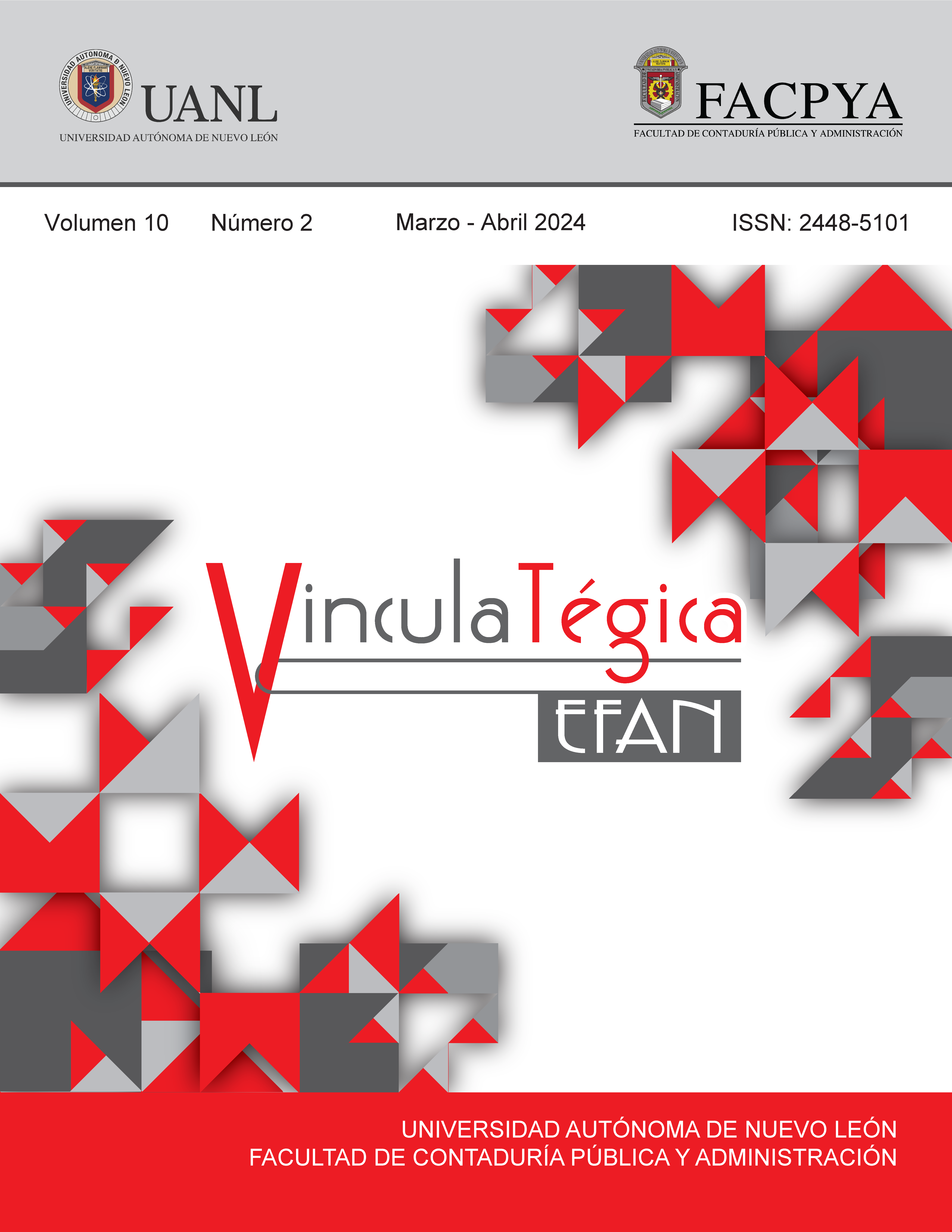Understanding Daniel Pink's motivation theory from a qualitative approach
DOI:
https://doi.org/10.29105/vtga10.2-413Keywords:
Motivation, Purpose, Autonomy, Mastery, Human behaviorAbstract
The purpose of this research is to identify how Pink's motivation theory 3.0 and how the various elements of the model (autonomy, mastery and purpose) influence human behavior. Through research, experiments and real cases related to motivation, Pink shows us that what really works is intrinsic motivation, as an innovative solution to managing talent in agile environments. Different approaches to the concept of motivation by various scientists and researchers were reviewed, treated as a singular construct, recent contributions suggest that people are moved to act by very different factors, with highly varied experiences and consequences.
Downloads
References
Alvarez, J. y Sainz, M. (2022). Factores motivacionales y su impacto en los indicadores educativos de una IEMS pública. Vinculatégica EFAN, 8(5), 14-27. https://doi.org/10.29105/vtga8.5-187 DOI: https://doi.org/10.29105/vtga8.5-187
Chamorro-Premuzic, Tomas. (10 de abril 2013). Does Money Really Affect Motivation? A Review of the Research. Harvard Business Review. https://hbr.org/2013/04/does-money-really-affect-motiv
Deci, E. L. (1971). “Effects of externally mediated rewards on intrinsic motivation. Journal of Personality and Social Psychology, 18(1), 105-115. DOI: https://doi.org/10.1037/h0030644
Deci, E. L. (1972). Intrinsic Motivation, Extrinsic Reinforcement and Inequity “Journal of Personality and Social Psychology, 22(1), 113-120. DOI: https://doi.org/10.1037/h0032355
Deci, E. L., & Ryan, R. M. (2008). Facilitating optimal motivation and psychological well-being across life's domains. Canadian Psychology / Psychologie canadienne, 49(1), 14–23. https://doi.org/10.1037/0708-5591.49.1.14 DOI: https://doi.org/10.1037/0708-5591.49.1.14
Diez Ortega, M. C. (2021). La motivación 3.0 en la Gestión del Talento en las Organizaciones. [Tesis de grado, Universidad de Valladolid, España] https://uvadoc.uva.es/bitstream/handle/10324/49474/TFG-L2918.pdf?sequence=1&isAllowed=y
Fang, M., Gerhart, B., y Ledford Jr, G. E. (2013). Negative effects of extrinsic rewards on intrinsic motivation: More smoke than fire. World at Work Quarterly, 16(2), 17-29. https://www.formapex.com/telechargementpublic/ledford2013a.pdf
Gerhart, B.A., y Fang, M. (2015). Pay, Intrinsic Motivation, Extrinsic Motivation, Performance, and Creativity in the Workplace: Revisiting Long-Held Beliefs. Annual Review of Organizational Psychology and Organizational Behavior. 2, 489-521. http://doi.org/10.1146/annurev-orgpsych-032414-111418 DOI: https://doi.org/10.1146/annurev-orgpsych-032414-111418
Griffin, R., Phillips, J. y Gully, S. (2020). Comportamiento organizacional (13th Edition). Cengage Learning Editores SA de CV.
Hernández-Sampieri, R., Fernández-Collado, C., & Baptista-Lucio, P. (2006). Análisis de los datos cuantitativos. Metodología de la investigación, 407-499.
Jiménez, M. (2007). Motivación intrínseca. Competencia, autodeterminación y control. Emoción y motivación: La adaptación humana. Madrid: Centro de Estudios Ramón Acelles S. A.
Lahmann, J. (2019). La empresa motivada. Barcelona, España: Libros de Cabecera S.L.
Madero, S. M. (2019). Factores de la teoría de Herzberg y el impacto de los incentivos en la satisfacción de los trabajadores. Acta Universitaria 29, e2153. doi. http://doi.org/10.15174.au.2019.2153 DOI: https://doi.org/10.15174/au.2019.2153
Madero, S.M. (2023). Percepción de la jerarquía de necesidades de Maslow y su relación con los factores de atracción y retención del talento humano. Contaduría y Administración, 68(1), 235-259. DOI: https://doi.org/10.22201/fca.24488410e.2023.3416
Martin, A.J. (2008). Enhancing student motivation and engagement: The effects of a multidimensional intervention. Contemporary Educational Psychology, 33, 239-269. DOI: 10.1016/j.cedpsych.2006.11.003. DOI: https://doi.org/10.1016/j.cedpsych.2006.11.003
Melwin, M. (2019). Leadership & Motivation 3.0 - A new dimension on workplace motivation. Pallikkutam, 56-59. https://www.researchgate.net/publication/341867083_Leadership_Motivation_30_-_A_new_dimension_on_workplace_motivation
Naranjo Pereira, María Luisa (2009). Motivación: perspectivas teóricas y algunas consideraciones de su importancia en el ámbito educativo. Revista Educación, 33(2),153-170. https://www.redalyc.org/pdf/440/44012058010.pdf DOI: https://doi.org/10.15517/revedu.v33i2.510
Pink, D. (2009). Drive, la sorprendente verdad de lo que nos motiva. Barcelona, España : Grupo Planeta.
Quinn, R., E. y Thakor A. V. (2018). Creating a Purpose-Driven Organization. Harvard Business Review, https://hbr.org/2018/07/creating-a-purpose-driven-organization
Ríos Hernández, A., Mendoza Gómez, J., y Vázquez Treviño, D. (2022). Factores del capital humano en la competitividad organizacional: Elaboración, validación de contenido y confiabilidad de un instrumento de medición. VinculaTégica, 8(4), 39-51. https://doi.org/10.29105/vtga8.4-206 DOI: https://doi.org/10.29105/vtga8.4-206
Rueda, I., Fernández, A. y Herrero, A. (2012). Estudiantes universitarios y emprendimiento: determinantes psicológicos de la intención de creación de un negocio propio. FAEDPYME International Review, 1(2), 9-15. https://dialnet.unirioja.es/servlet/articulo?codigo=4834621 DOI: https://doi.org/10.15558/fir.v1i2.21
Ryan, R. M. (1998). Commentary: Human psychological needs and the issues of volition, control, and outcome focus. In J. Heckhausen & C. S. Dweck (Eds.), Motivation and self-regulation across the life span (pp. 114–133). Cambridge University. https://doi.org/10.1017/CBO9780511527869.006 DOI: https://doi.org/10.1017/CBO9780511527869.006
Williams, G., Rodin, G., Ryan, R., Grolnick, W., y Deci, E. (1998). Autonomous regulation and long-term medication adherence in adult outpatients. Health Psychology, 17(3), 269–276. https://doi.org/10.1037//0278-6133.17.3.269 DOI: https://doi.org/10.1037//0278-6133.17.3.269
Wu, M. (26 de noviembre de 2014). From Maslow’s Needs to Pink’s Drive: https://motivationsgame.wordpress.com/2014/11/26/from-maslows-needs-to-pinks-drive/
Downloads
Published
How to Cite
Issue
Section
License
Copyright (c) 2023 Sergio Madero, Carolina Soto Ontiveros, Claudia Arias Meza

This work is licensed under a Creative Commons Attribution 4.0 International License.
a). Authors keep copyright and give the journal the right of the first publication of the work under a Creative Commons attribution license. This license allows others to share the work as long as original authorship and initial publication in this journal is acknowledged.
b). Authors may make other independent and additional contractual agreements for the non-exclusive distribution of the version of the article published in this journal (e.g., include it in an institutional repository or publish it in a book) as long as they clearly indicate that the work was published for the first time in this journal.







